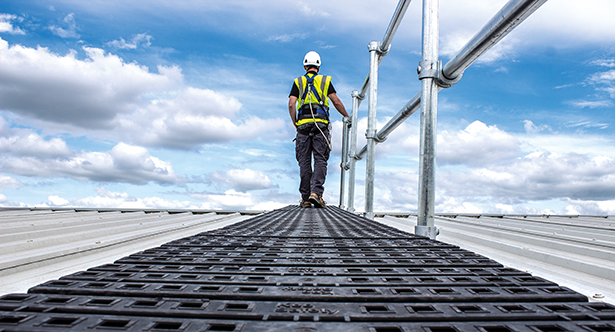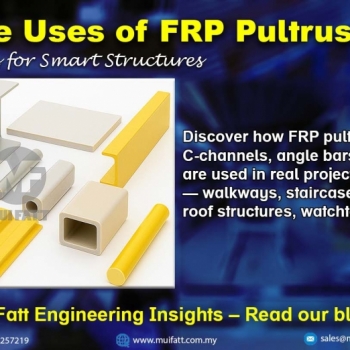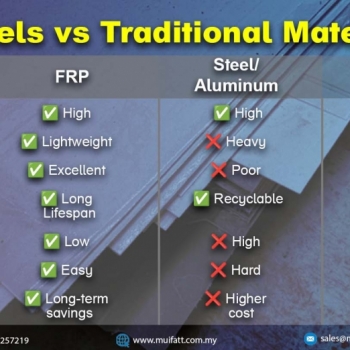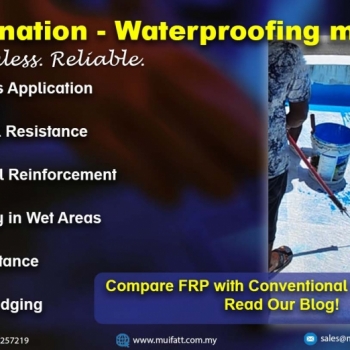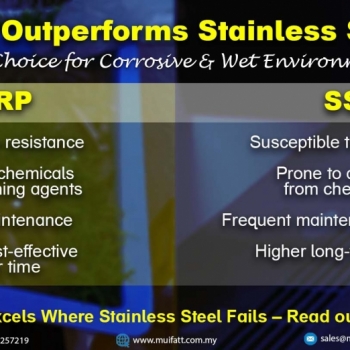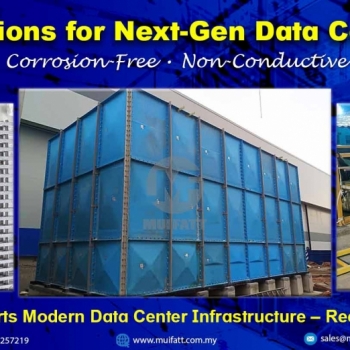FRP pultruded profiles are reshaping structural possibilities across Malaysia. From STP staircases to public park shelters, explore how these modular components enable custom FRP solutions—only from Mui Fatt.
Rooftop Walkways: Safety, Modularity, Ease
12 Jul 2023
Have you ever wondered how workers safely navigate rooftops? The answer lies in rooftop walkways. These ingenious systems, including guardrails and platforms, provide a secure passage with treads, preventing accidents and injuries from rooftop falls. Whether it's for routine maintenance, inspections, or repairs, rooftop walkways are essential for ensuring worker safety on roofs.
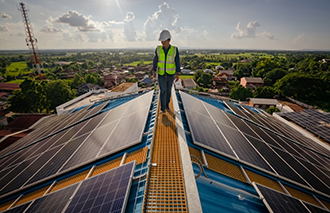
Rooftop walkways with sturdy steps, slip-resistant surfaces, and guardrails act as a lifeline for workers. These walkways create designated sections on roofs, improving efficiency and streamlining projects. Incorporating rooftop platforms and treads into your building's design prioritizes safety and enhances accessibility for all.
The importance of rooftop walkways and platforms cannot be overstated when it comes to ensuring safety on roofs. So why take unnecessary risks when you can invest in a reliable solution like guardrails? Let's explore the world of rooftop walkways, platforms, and guardrails and discover how they make every step count.
Remember: Safety is paramount—don't let your work go any further without considering the benefits of rooftop walkways! These platforms provide the necessary treads to overcome the challenges of working at heights.
Key Reasons to Consider Modular Rooftop Walkway Systems
Easy installation and customization
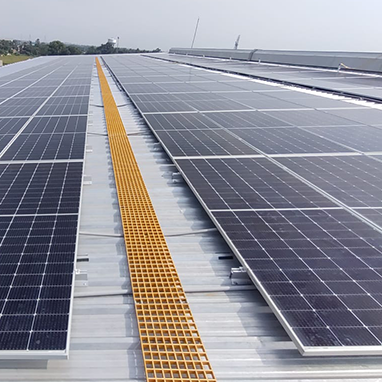 Modular rooftop walkway systems offer a hassle-free installation process, making them an excellent choice for any rooftop access needs. These systems are designed with simplicity in mind, allowing for easy assembly and disassembly without the need for specialized tools or extensive training. With their modular design, these walkways can be customized to fit the specific dimensions and layout of any rooftop, ensuring a seamless integration.
Modular rooftop walkway systems offer a hassle-free installation process, making them an excellent choice for any rooftop access needs. These systems are designed with simplicity in mind, allowing for easy assembly and disassembly without the need for specialized tools or extensive training. With their modular design, these walkways can be customized to fit the specific dimensions and layout of any rooftop, ensuring a seamless integration.
Cost-effective compared to traditional walkways
One of the key advantages of modular rooftop walkway systems is their cost-effectiveness when compared to traditional walkways. Traditional walkways often require significant construction work and materials, resulting in high expenses. In contrast, modular systems provide a more affordable alternative that does not compromise on quality or functionality. By eliminating the need for complex construction processes, these systems save both time and money.
Durable and long-lasting solution for rooftop access
Durability is paramount. Modular rooftop walkway systems are built to withstand various weather conditions and heavy foot traffic over extended periods. Constructed from robust materials such as galvanized steel or aluminum, these walkways offer exceptional strength and longevity. Their corrosion-resistant properties ensure they can endure exposure to moisture, UV rays, and other environmental factors without deteriorating.
Increase roof's longevity
Installing a modular rooftop walkway system not only provides safe access but also contributes to extending the lifespan of your roof. By creating designated pathways for maintenance personnel or visitors, these systems protect the roofing surface from unnecessary wear and tear caused by constant foot traffic. Moreover, they prevent accidental damage that could occur if people navigate across sensitive areas of the roof without proper guidance.
Easier access to equipment
In addition to providing safe passage for individuals on the rooftop, modular walkway systems also facilitate easier access to equipment located there. Whether its HVAC units, solar panels, or other rooftop installations, these walkways ensure convenient and secure pathways for maintenance personnel to reach the equipment. This accessibility streamlines maintenance operations and reduces the risk of accidents or damage during equipment servicing.
Enhancing Safety with Rooftop Walkways
Minimizes the risk of slips, trips, and falls
Safety should always be a top priority. One of the most effective ways to enhance safety in these environments is by implementing rooftop walkways. These walkways provide a designated path for workers, minimizing the risk of slips, trips, and falls.
Rooftop work can be hazardous due to various factors such as uneven surfaces, debris, and slippery conditions. Without proper fall protection measures in place, employees are at a higher risk of accidents and injuries. However, by installing rooftop walkways with guardrails and safe access points, workers have a secure route to navigate across the building's roof.
Provides a designated path for workers on rooftops
Rooftop walkways offer more than just safe access; they also provide a clear and defined route for workers. Instead of having employees wander aimlessly across the roof surface or potentially stepping on fragile areas, these designated paths ensure that individuals stay within safe boundaries.
By clearly marking out the areas where employees can safely work or move around, rooftop walkways help prevent accidental damage to fragile roofing materials. This not only protects the integrity of the building but also reduces repair costs caused by unintentional foot traffic in sensitive areas.
Increases overall safety awareness in rooftop environments
Installing rooftop walkways goes beyond providing physical structures; it also raises overall safety awareness among workers operating in rooftop environments. The presence of these walkways serves as a constant reminder that caution must be exercised when navigating rooftops.
Furthermore, companies can use this opportunity to reinforce safety training programs for their employees. By incorporating specific guidelines regarding the use of rooftop walkways into training sessions, workers become more conscious of potential hazards and learn how to mitigate risks effectively.
In addition to promoting safer practices among employees working on rooftops directly, rooftop walkways also create a safer environment for other individuals who may need to access the roof. For instance, maintenance personnel or contractors can utilize these walkways to perform their tasks without endangering themselves or others.
Applications and Uses of Rooftop Walkways: Solar Panel Maintenance
Safe Access for Solar Panel Cleaning and Maintenance
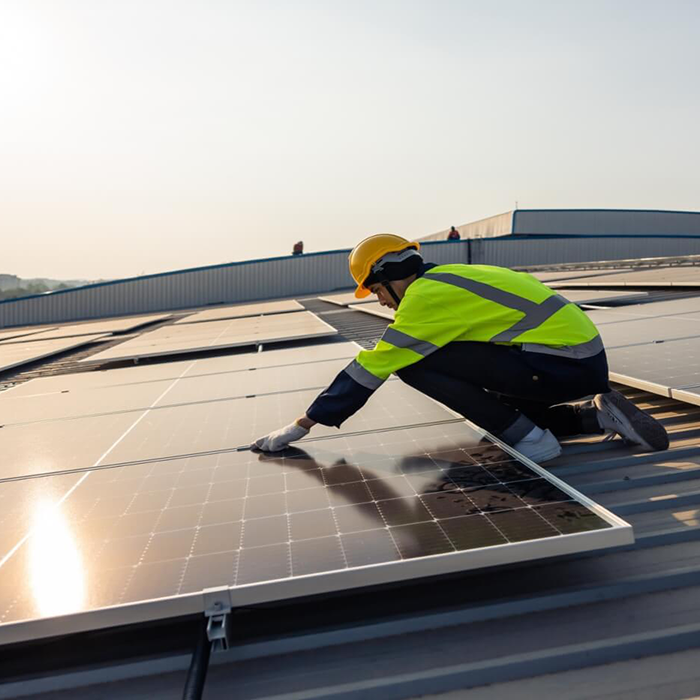 Rooftop walkways are an essential component. These walkways provide a secure path for workers, enabling them to navigate across the roof surface without the risk of slipping or falling. With their anti-slip surfaces and sturdy construction, rooftop walkways offer a stable platform for technicians to carry out their tasks with confidence.
Rooftop walkways are an essential component. These walkways provide a secure path for workers, enabling them to navigate across the roof surface without the risk of slipping or falling. With their anti-slip surfaces and sturdy construction, rooftop walkways offer a stable platform for technicians to carry out their tasks with confidence.
Solar panels are often installed on rooftops, making them susceptible to various environmental factors such as dirt, dust, and debris accumulation. Regular cleaning is crucial to maintain optimal energy production levels. By having designated pathways through rooftop walkways, maintenance personnel can easily access all areas of the solar panel installation without causing damage to delicate components.
Protection for Fragile Solar Panels during Inspections or Repairs
During inspections or repairs of solar panels, utmost care must be taken to prevent any accidental damage that could compromise their efficiency. Rooftop walkways play a vital role in safeguarding these fragile installations from unnecessary harm. By utilizing these designated paths, technicians can avoid stepping directly on the panels themselves, reducing the risk of cracking or breaking them.
Rooftop walkways also act as a protective barrier between maintenance personnel and the underlying roofing material. This prevents accidental punctures or other forms of damage that could lead to leaks and costly repairs down the line. The use of these walkways ensures that both the solar panels and roofing structure remain intact throughout any necessary inspections or repairs.
Facilitating Efficient Workflow for Solar Panel Technicians
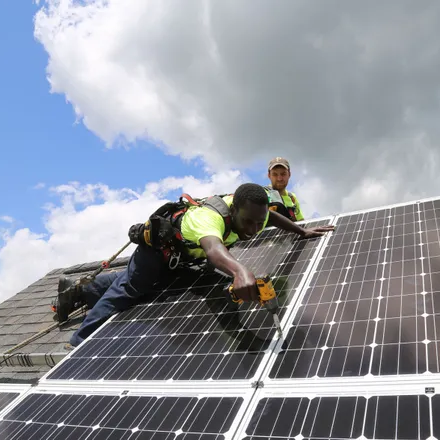 Efficiency is keys time-consuming procedures can impact overall productivity and increase costs. Rooftop walkways contribute significantly to streamlining workflow processes for technicians by providing clear pathways between different sections of the installation.
Efficiency is keys time-consuming procedures can impact overall productivity and increase costs. Rooftop walkways contribute significantly to streamlining workflow processes for technicians by providing clear pathways between different sections of the installation.
With rooftop walkways, technicians can move swiftly and easily from one panel to another, minimizing the time spent on navigating the roof surface. This allows them to focus more on the actual maintenance tasks at hand, such as cleaning, inspecting, or replacing components. By optimizing workflow efficiency through the use of these walkways, solar panel technicians can complete their duties in a timely manner while ensuring high-quality maintenance.
Meeting Safety Code Compliance for Rooftop Access in Malaysia
Ensures compliance with DOSH regulations for fall protection
Ensuring compliance with safety codes and regulations is of utmost importance. One key aspect of meeting safety code compliance is adhering to the fall protection standards set by Department of Occupational Safety and Health (DOSH). These regulations are in place to prevent falls and protect workers who need access to rooftops.
To comply with DOSH’s fall protection requirements, a rooftop walkway can play a crucial role. By providing a designated pathway that keeps workers away from unprotected edges, it significantly reduces the risk of accidental falls. This ensures that your facility meets DOSH’s stringent guidelines, safeguarding the well-being of your employees.
Meets local building codes regarding rooftop accessibility
In addition to DOSH regulations, it is essential for facilities to meet local building codes. Local authorities often have specific requirements regarding safe access points and pathways on rooftops. Failure to comply with these codes can result in penalties or even legal consequences.
A rooftop walkway designed according to local building codes ensures that your facility remains compliant with these regulations. It provides a clear and secure route for personnel accessing the roof while maintaining structural integrity. By aligning with local building codes, you demonstrate your commitment to maintaining safe practices within your organization.
Reduces liability by providing a safe working environment
Implementing a rooftop walkway not only helps meet safety code compliance but also reduces liability by providing a safe working environment for employees and contractors alike. Without proper access provisions, individuals may resort to unsafe methods or take unnecessary risks when accessing rooftops.
By installing a designated walkway, you eliminate potential hazards associated with climbing ladders or stepping on fragile surfaces. This mitigates the risk of accidents and injuries caused by falls or other accidents during roof access activities. Ultimately, reducing liability translates into cost savings through fewer workers' compensation claims and potential legal disputes.
Materials Option for Roof Walkways Fabrication
Steel Walkways: Strength and Durability in Harsh Conditions
Steel walkways are a popular choice for rooftop walkway fabrication due to their exceptional strength and durability. These walkways are designed to withstand even the harshest conditions, making them ideal for industrial settings or areas prone to heavy foot traffic. The robust nature of steel ensures that it can bear significant weight without compromising its structural integrity.
One of the key advantages of using steel for walkway fabrication is its ability to resist corrosion. This makes it suitable for outdoor installations where exposure to moisture and harsh weather conditions is inevitable. Steel walkways can be customized to fit any roof layout or design, providing flexibility in installation options.
Here are some notable features of steel walkways:
- Exceptional strength and load-bearing capacity
- Resistant to corrosion, ensuring longevity
- Customizable designs to fit various roof layouts
Aluminum Walkways: Lightweight Yet Sturdy Solutions
For those seeking a lightweight alternative without compromising on strength, aluminum walkways offer an excellent solution. Aluminum is known for its low density, making these walkways significantly lighter than their steel counterparts. This lightweight characteristic makes installation easier and reduces the overall load on the roof structure.
Despite being lightweight, aluminum walkways still provide sturdy support and can withstand considerable foot traffic. They are also resistant to corrosion, ensuring longevity even in challenging environments. Furthermore, aluminum's natural aesthetic appeal adds a touch of modernity to rooftops.
Consider the following advantages of aluminum walkways:
- Lightweight construction for easy installation
- Corrosion-resistant properties for enhanced durability
- Sleek and modern appearance
Fiberglass Walkways: Corrosion-resistant, Weather-resistant, Slip-resistant Solutions
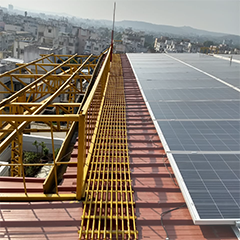 These walkways are composed of a combination of fiberglass and plastic resin, resulting in a highly durable and versatile material.
These walkways are composed of a combination of fiberglass and plastic resin, resulting in a highly durable and versatile material.
Fiberglass walkways are specifically designed to withstand harsh environments. They are corrosion-resistant, making them suitable for areas exposed to chemicals or coastal regions with high salt content in the air. They possess excellent weather resistance, ensuring that they can endure extreme temperatures without warping or deteriorating.
Moreover, slip resistance is a crucial factor. Fiberglass walkways incorporate anti-slip properties, providing secure footing even in wet or slippery conditions. This feature significantly reduces the risk of accidents and ensures the well-being of those utilizing the rooftop walkway.
Features of Roof Walkway System
The rooftop walkway system is designed to provide a safe and secure passage for workers or visitors on rooftops. With its slip-resistant surface, this innovative system ensures that individuals can move around with confidence, even in wet or slippery conditions.
One of the key features of the rooftop walkway system is its slip-resistant surface. The material used in the construction of these walkways offers excellent traction, reducing the risk of slips and falls. Whether it's rain, or any other form of moisture, individuals can trust that they will have secure footing on the rooftop walkway.
Accidental slips off the sides can be a major concern when working at heights. However, with raised edges incorporated into the design of the rooftop walkway system, such accidents are effectively prevented. These raised edges act as a barrier, providing an additional layer of safety by keeping individuals from inadvertently stepping off the sides.
Flexibility in configuration is another advantage offered by rooftop walkway systems. Thanks to their easy-to-install modular design, these systems can be customized to suit various roof layouts and structures. This flexibility allows for efficient utilization of available space while ensuring optimal safety for everyone accessing the rooftop.
Installing a rooftop walkway system is a straightforward process due to its modular nature. The components easily interlock with each other, eliminating complex installation procedures. This simplicity not only saves time but also reduces labor costs associated with setup.
Rooftop walkway systems can be used on various roof types, including standing seam roofs which have become more popular in recent years. The FRP walkway system is also compatible with composite, metal, membrane, and trapezoidal roof structures. The versatility of these systems makes them suitable for various applications across different industries.
Walkway System Fiberglass Grating Configuration Option: Molded and Pultruded
Fiberglass grating is a versatile and durable solution for walkway systems, providing a safe and reliable surface for pedestrians to traverse. Two popular choices are molded grating and pultruded grating. Each option offers unique benefits and can be tailored to specific project requirements. Let's delve into these configurations in more detail.
Molded Grating: High Strength-to-Weight Ratio
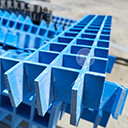 Molded grating is known for its exceptional strength-to-weight ratio, making it an ideal choice for rooftop walkways that require both durability and lightweight construction. The manufacturing process involves combining glass fibers with a resin matrix, resulting in a strong and corrosion-resistant material. This configuration offers several advantages:
Molded grating is known for its exceptional strength-to-weight ratio, making it an ideal choice for rooftop walkways that require both durability and lightweight construction. The manufacturing process involves combining glass fibers with a resin matrix, resulting in a strong and corrosion-resistant material. This configuration offers several advantages:
- Strength: Despite its lightweight nature, molded grating boasts impressive strength properties, capable of withstanding heavy loads without compromising safety.
- Slip Resistance: The textured surface of molded grating enhances slip resistance, minimizing the risk of accidents even in wet or slippery conditions.
- Chemical Resistance: With inherent resistance to chemicals such as acids and alkalis, molded grating provides long-lasting performance in harsh environments.
- Easy Installation: Molded grating panels are designed for easy installation, reducing labor costs and project timelines.
Pultruded Grating: Excellent Load-Bearing Capacity
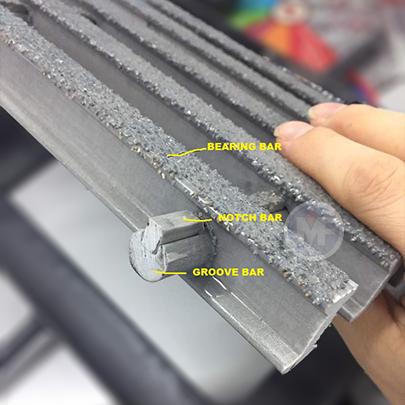 Pultruded grating is renowned for its exceptional load-bearing capacity, making it suitable for applications where heavy equipment or machinery may be present on the rooftop walkway. It is created by pulling glass fibers through a resin bath before curing them under heat and pressure. Here are some key advantages of pultruded grating:
Pultruded grating is renowned for its exceptional load-bearing capacity, making it suitable for applications where heavy equipment or machinery may be present on the rooftop walkway. It is created by pulling glass fibers through a resin bath before curing them under heat and pressure. Here are some key advantages of pultruded grating:
- Load-Bearing Capacity: Pultruded gratings have superior load-bearing capabilities compared to other materials like steel or aluminum while still maintaining a lightweight profile.
- Fire Retardant: This configuration offers excellent fire retardant properties, making it a safe choice for rooftop walkways where fire hazards may be a concern.
- Longevity: Pultruded grating exhibits exceptional durability and longevity, even in harsh weather conditions, ensuring minimal maintenance requirements over time.
- Customization Options: Various configurations are available to meet specific project requirements, including different bar spacings and surface patterns.
Tailoring the Configuration to Project Requirements
Both molded and pultruded grating configurations provide distinct advantages for rooftop walkway systems. However, the choice between them ultimately depends on the specific needs of each project. Considerations such as load requirements, environmental factors, and budget constraints play crucial roles in determining the optimal configuration.
For instance, if weight reduction is a priority without compromising strength or slip resistance, molded grating may be the preferred option. On the other hand, if heavy equipment will be present on the walkway or fire retardant is essential, pultruded grating would be more suitable.
By understanding the unique benefits of each configuration option and considering project-specific requirements, it becomes easier to select the most appropriate fiberglass grating system for rooftop walkways.
Rooftop Walkway Grating Product Suggestion
If you're looking for a reliable and durable solution to create a safe rooftop walkway, consider our MuiGrate Grating. With its exceptional features and innovative design, this grating product is an ideal choice for enhancing safety and functionality in any rooftop setting.
Enhanced Slip Resistance with Fiberglass Gritted Finishing
Safety is paramount. Our MuiGrate Grating offers a fiberglass gritted finishing that significantly enhances slip resistance. This feature ensures that even in wet or slippery conditions, individuals can confidently traverse the walkway without the risk of accidents or injuries. The added traction provided by the gritted surface makes it suitable for various applications, including high-traffic areas or locations prone to moisture.
Optimal Rail Spacing Width and Grating Thickness

To ensure structural integrity and stability, it's crucial to consider the rail spacing width and grating thickness when selecting a rooftop walkway grating. MuiGrate Grating provides customizable options to meet specific requirements. By choosing the appropriate rail spacing width and grating thickness, you can tailor your walkway's design according to load-bearing needs while maintaining safety standards.
Easy Drainage and Debris Removal with Open Mesh Design
The open mesh design of the MuiGrate Grating allows for efficient drainage of rainwater, preventing pooling on the walkway surface. This design facilitates easy removal of debris such as leaves or small objects that may accumulate over time. By allowing water and debris to pass through, the open mesh design minimizes maintenance efforts while ensuring a clean and hazard-free walking surface.
Corrosion-Resistant Properties for Long-Lasting Performance
Rooftop environments are often exposed to harsh weather conditions that can accelerate corrosion processes. However, with its corrosion-resistant properties, MuiGrate Grating is built to withstand these challenges. Made from durable fiberglass materials, this rooftop walkway is designed to resist rust, chemicals, and the harmful effects of UV rays. This ensures that the walkway remains structurally sound and aesthetically pleasing for an extended period, reducing the need for frequent replacements or repairs.
Various Grating Clip Options: C-Clip, M-Clip, L-Clip for Molded Grating; M-Clip, Insert Clip, G-Clip for Pultruded Grating
Grating clips are essential for rooftop walkways because they keep the grating securely in place. This is crucial for the safety of people using the walkway. To further enhance installation efficiency and stability, MuiGrate Grating provides different grating clip options. These clips enable secure attachment of the grating to supporting structures while allowing for easy adjustment or removal when necessary. To make sure that everyone stays safe, it is crucial to select the appropriate grating clip for your rooftop walkway. Each choice has its own benefits when it comes to how easily it can be installed and the overall strength of the structure.
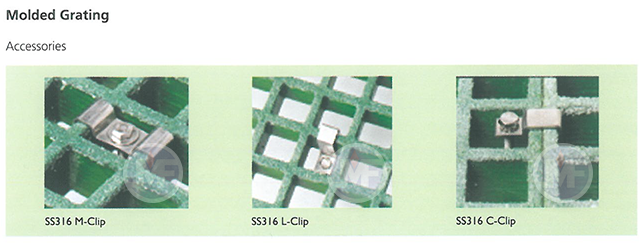
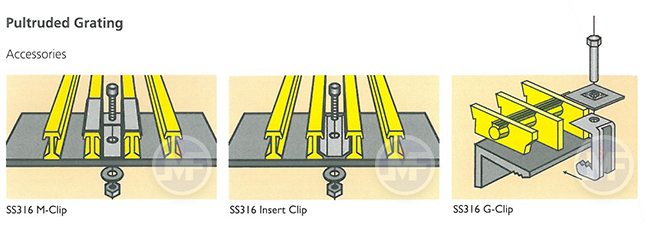
Modular & Efficient: Cost-Efficient Preassembly
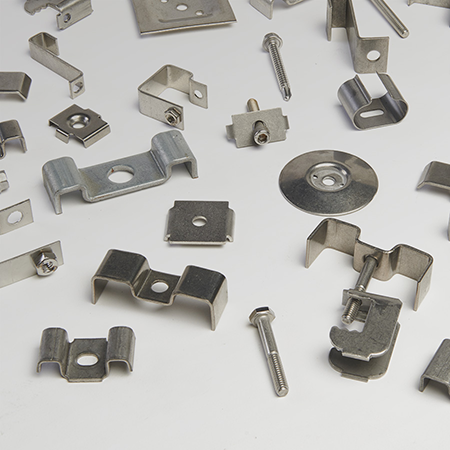 Preassembled walkway components are revolutionizing the rooftop construction industry, offering a cost-efficient solution that saves both time and money. By employing a modular design and utilizing structural steel, these preassembled walkways provide numerous benefits for companies seeking efficient rooftop access solutions.
Preassembled walkway components are revolutionizing the rooftop construction industry, offering a cost-efficient solution that saves both time and money. By employing a modular design and utilizing structural steel, these preassembled walkways provide numerous benefits for companies seeking efficient rooftop access solutions.
One of the key advantages of preassembled walkway components is their ability to reduce installation time and costs. Instead of spending valuable hours on-site fabricating each individual piece, companies can simply assemble the pre-made components, significantly cutting down on labor expenses. This streamlined approach not only saves money but also ensures that the walkway is installed quickly and efficiently.
The modular design of these walkways allows for easy expansion or reconfiguration as needed. Companies can easily add or remove sections to accommodate changes in equipment layout or modifications to the roof structure. This flexibility eliminates the need for costly and time-consuming custom fabrication work when alterations are required. With preassembled walkways, companies have the freedom to adapt their rooftop access systems to meet evolving needs without breaking the bank.
Preassembled walkways offer another way to save costs by using fiberglass as fabrication materials. These walkways are made with strong fiberglass that can withstand different weather conditions, providing excellent protection against water. This means that there is no need for extra waterproofing measures like separate membranes or sealants, saving companies both time and money during the installation process.
Furthermore, by opting for preassembled walkways, companies can minimize labor expenses associated with ongoing maintenance and repairs. The durable structural steel used in these systems ensures longevity and reduces the likelihood of frequent repairs or replacements. Any necessary maintenance tasks can be completed more efficiently due to the standardized nature of preassembled components.
Understanding the Hierarchy of Fall Protection for Rooftop Walkways
Fall prevention through guardrails and handrails is the first priority
Fall prevention should always be the top priority. Installing sturdy guardrails and handrails is essential in creating a secure environment for anyone accessing these elevated areas.
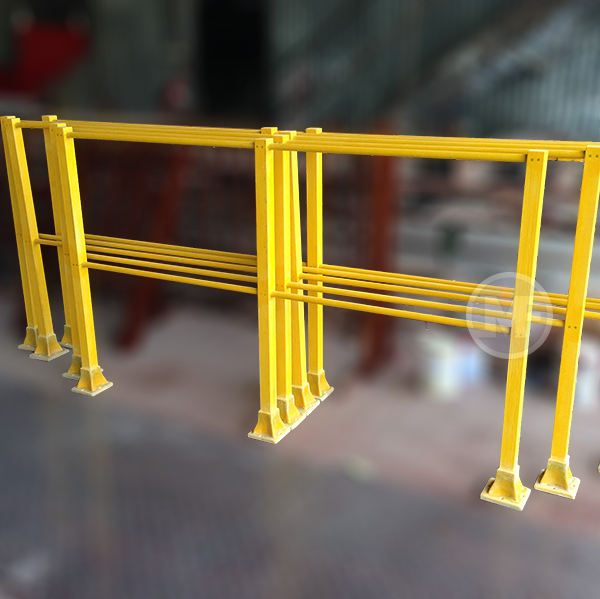 Guardrails act as a physical barrier, preventing accidental falls by providing a protective boundary around the rooftop walkway. They are typically made of durable materials such as steel, aluminum, or fiberglass designed to withstand harsh weather conditions and provide long-lasting protection.
Guardrails act as a physical barrier, preventing accidental falls by providing a protective boundary around the rooftop walkway. They are typically made of durable materials such as steel, aluminum, or fiberglass designed to withstand harsh weather conditions and provide long-lasting protection.
Handrails, on the other hand, offer additional support and stability while navigating the rooftop walkway. They are usually installed along staircases or ramps, allowing individuals to maintain balance and prevent slips or trips.
By implementing robust guardrails and reliable handrails, you establish an initial level of defense against potential falls. These safety measures create a visible boundary that serves as a constant reminder to those traversing the rooftop walkway to exercise caution.
Fall arrest systems provide protection in case of a fall
While fall prevention measures significantly reduce the risk of accidents on rooftop walkways, there may still be instances where falls occur despite all precautions. This is where fall arrest systems come into play.
Fall arrest systems are designed to minimize injuries by safely arresting a person's fall before they hit the ground or any lower level. These systems consist of various components working together harmoniously to ensure maximum protection during an unexpected descent.
Some common elements of fall arrest systems include:
- Harnesses: Individuals wear full-body harnesses that distribute forces evenly across their bodies when subjected to sudden stops.
- Anchorage Points: Secure attachment points are strategically placed throughout the rooftop area, allowing workers to connect their harnesses.
- Lanyards and Lifelines: These flexible lines connect the worker's harness to anchor points, absorbing energy upon impact and reducing injury risks.
- Shock Absorbers: Incorporated into the system, shock absorbers further reduce the impact forces experienced by individuals during a fall.
By implementing a comprehensive fall arrest system, you provide an additional layer of protection for workers or visitors on rooftop walkways. This ensures that even in the event of a fall, injuries are minimized, and lives are potentially saved.
Personal protective equipment (PPE) serves as a last line of defense
In addition to guardrails and fall arrest systems, personal protective equipment (PPE) acts as a crucial last line of defense against falls on rooftop walkways. PPE serves as a final safeguard when all other preventive measures have been exhausted or when specific tasks require additional protection.
Common types of PPE used in rooftop environments include:
- Safety helmets: Protecting the head from falling objects or potential impacts.
- Non-slip footwear: Offering enhanced grip and stability on slippery surfaces.
- High-visibility vests: Ensuring individuals remain visible to others working in the area, reducing the risk of collisions.
- Safety harnesses: Used alongside fall arrest systems to secure individuals during elevated work tasks.
It's essential to select appropriate PPE based on the specific hazards present on the rooftop walkway. Regular inspections and maintenance should be conducted to ensure that PPE remains effective and in good condition.
Remember, while PPE is an important safety measure, it should never replace proper fall prevention techniques or reliable fall arrest systems.
Conclusion: The Importance of Rooftop Walkways
In conclusion, rooftop walkways play a crucial role in ensuring safety and accessibility for various applications. By utilizing modular rooftop walkway systems, you can enjoy several benefits such as enhanced safety measures, compliance with safety codes, efficient installation, and improved maintenance.
These walkway systems provide a reliable solution for navigating rooftops while minimizing the risk of accidents. They offer a secure pathway for workers and maintenance personnel to access different areas of the roof without endangering themselves or damaging the structure.
One significant application of rooftop walkways is in solar panel maintenance. With these walkways in place, technicians can easily reach and service solar panels without compromising their safety or causing any damage to the delicate equipment. This ensures that solar energy systems continue to perform optimally while reducing maintenance costs.
Rooftop walkways are an essential component. These systems are designed to meet specific regulations and standards set by authorities to ensure safe working conditions at elevated heights. By incorporating compliant rooftop walkways into your building design or retrofitting existing structures, you can avoid penalties and legal issues while prioritizing worker safety.
Materials used for fabricating roof walkways vary depending on specific requirements. Options like fiberglass grating offer durability, corrosion resistance, and lightweight properties that make them ideal for rooftop applications. Molded and pultruded configurations provide additional customization choices based on project needs.
To ensure optimal performance and longevity of your rooftop walkway system, selecting suitable grating products is vital. Consider factors such as load-bearing capacity, slip resistance, ease of installation, and maintenance requirements when making your decision.
Modularity plays a key role in the efficiency of rooftop walkway systems. Preassembled components allow for quick installation with minimal disruption to ongoing operations or construction projects. This saves time and reduces costs associated with labor-intensive assembly processes.
Understanding the hierarchy of fall protection is crucial for rooftop walkway safety. By implementing appropriate fall protection measures such as guardrails, handrails, and non-slip surfaces, you can significantly reduce the risk of accidents and injuries.
In conclusion, rooftop walkway systems are essential for ensuring safety, accessibility, and compliance in various applications. By investing in these systems, you can create a secure environment for workers while optimizing maintenance procedures. Choose the right materials and products that best suit your specific needs to maximize the benefits of rooftop walkways.
Talk to us for your project today! WhatsApp or email – sales@muifatt.com.my
We guarantee our expertise to you.
Visit our product page for more product details – SolarStride FRP Rooftop Walkway System
FAQs
Q: Are rooftop walkways suitable for all types of roofs?
Rooftop walkways can be designed to accommodate different roof types and configurations. It is important to consult with experts or manufacturers to determine the most suitable solution for your specific roof structure.
Q: Can rooftop walkway systems be customized?
Yes, modular rooftop walkway systems offer customization options to meet specific project requirements. This includes selecting materials, dimensions, load-bearing capacities, and other features based on your needs.
Q: How long does it take to install a rooftop walkway system?
The installation time of a rooftop walkway system depends on various factors such as the size of the project and complexity of the roof structure. However, modular systems generally allow for faster installation compared to traditional construction methods.
Q: Do I need professional help to install a rooftop walkway system?
While some individuals may have the expertise to install a rooftop walkway system themselves, it is recommended to seek professional assistance. Professionals have knowledge about safety regulations and can ensure proper installation according to industry standards.
Q: Can I retrofit an existing building with a rooftop walkway system?
Yes, existing buildings can be retrofitted with rooftop walkway systems. However, it is important to assess the structural integrity of the roof and consult with professionals who specialize in retrofitting projects.
Disclaimer:-
The information provided on this website is for general informational purposes only and does not constitute legal advice. While we strive to ensure the accuracy and reliability of the information provided, we make no representations or warranties of any kind, express or implied, about the completeness, accuracy, reliability, suitability, or availability concerning the information contained herein. Any reliance you place on such information is therefore strictly at your own risk. This website may contain links to other third-party websites. Such links are only for the convenience of the reader, user, or browser; which we do not warrant, recommend, endorse, or assume liability for the contents of the third-party sites.
Keep in touch with us should you be keen on receiving timely updates from us
- Website - https://www.muifatt.com.my/home/
- Facebook - https://www.facebook.com/muifattmarketing
- Instagram - https://www.instagram.com/muifattmarketing/
- Google - https://goo.gl/maps/WxVY13gNcaRTS7Jp6
- Youtube - http://www.youtube.com/@MuiFattMarketing
- TikTok - https://www.tiktok.com/@muifattmarketing
- LinkedIn - https://www.linkedin.com/company/mui-fatt-marketing-sdn-bhd-
- Linktree - https://linktr.ee/muifattmarketing
- Shopee - https://www.shopee.com.my/muifattmarketing
- Lazada - https://www.lazada.com.my/shop/mui-fatt-marketing
Recent Blog
Mui Fatt Engineering Insights - FRP Panel Tank Installation
Get to know the step-by-step assembly process of FRP sectional panel tanks, based on Mui Fatt’s industry-proven practices. This easy-to-digest guide is ideal for project managers, contractors, and technical personnel involved in water storage tank installation across Malaysia.
FRP Panels vs Traditional Alternatives: The Ultimate Guide to Durability and Sustainability
Explore why FRP (Fiberglass-Reinforced Plastic) panels outperform traditional materials like steel, plywood, and PVC in durability, sustainability, and cost-effectiveness. Discover real-world applications in MyKiosk projects and cold truck panel assembly, where FRP’s superior insulation, corrosion resistance, and lightweight properties deliver long-term benefits.
Comparing FRP Waterproofing with Traditional Systems
Is FRP lamination a better waterproofing method than traditional systems? Explore this complete guide with real project examples and see why FRP is gaining traction across Malaysia.
Benefits of FRP in Food Handling & Processing
With hygiene, durability, and corrosion resistance at its core, FRP (Fibreglass Reinforced Plastic) is becoming a preferred material in the food industry. This article explores why FRP is ideal for food handling equipment such as supermarket fish trays, water tanks, and food factory platforms, plus how Mui Fatt is delivering proven solutions through its successful FRP applications.
Mui Fatt Insights: Advanced Materials for Modern Needs
Is stainless steel the best for wet areas? This article explains why more industries are switching to FRP for its corrosion resistance, hygiene benefits, and longevity, especially in food displays and chemical exposure zones.
How FRP Supports Modern Data Center Infrastructure
Discover how fiberglass-reinforced plastic (FRP) is reshaping data center construction. Learn its key advantages, comparisons with other materials, and where to apply FRP—from rooftop chillers to cooling tanks.
Understanding FRP Filament Winding: Process, Benefits & Comparison
This article explores the FRP filament winding manufacturing method, how it differs from other FRP techniques, why it’s still widely used, and its long-term value for projects like high-strength tanks and cylinders.



